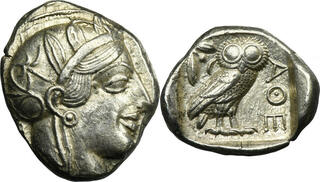| Salon Numizmatyczny Mateusz Wójcicki > Auction 13 | Auction date: 9 March 2024 |
| Lot number: 10012 Price realized: 380 EUR (Approx. 417 USD) Note: Prices do not include buyer's fees. | Show similar lots on CoinArchives Find similar lots in upcoming auctions on |
| Lot description: Greece, Attica, Athens, Tetradrachm Greece Attica, Athens, Tetradrachm 454-404 BC Obverse: head of Athena in the helmet facing right Reverse: owl standing to the right, with its head turned straight, in an upright position, with an olive branch and a crescent moon on the back, on the right side ΑΘΕ Diameter 26 mm, weight 17.18 g The Athenian owls were the first widely used international coins. In places where they were used commercially, some peoples began to mint their own versions, usually 100% imitating them, but sometimes not in every detail. Among the peoples who imitated the owls in the 5th and 4th centuries BC were Persians, Bactras, Phoenicians, Philistines, Judahans, Samarians, Egyptians, and Arabs. The production of owl imitations reached its peak in the 4th century BC, when the production of the official Athenian owls declined after the end of the Peloponnesian War in 404 BC. Peoples who used them still felt the need to have them. The production of imitative owls declined after the arrival of Alexander the Great and the spread of his coins. The only exception was South Arabia, where the Sabeans and Himyarites imitated New Style owls even in the 1st century BCE, and the obverse evolved from the female form of Athena to the male form. Grecja Attyka, Ateny, Tetradrachma 454-404 pne Awers: głowa Ateny w hełmie w prawo Rewers: sowa stojąca w prawo, z głową zwróconą na wprost, w postawie wyprostowanej, z oliwną gałązką i półksiężycem z tyłu, z prawej strony ΑΘΕ Średnica 26 mm, waga 17.18 g Ateńskie sowy były pierwszymi szeroko stosowanymi, międzynarodowymi monetami. W miejscach, w których były używane w handlu, niektóre ludy zaczęły wybijać ich własne wersje, zwykle naśladując je w 100%, ale czasem nie we wszystkich detalach. Wśród ludów naśladujących sówki w V i IV wieku pne byli Persowie, Baktrowie, Fenicjanie, Filistyńczycy, Judejczycy, Samarianie, Egipcjanie i Arabowie. Produkcja naśladownictw sówki osiągnęła swój szczyt w IV wieku pne, w momencie kiedy produkcja oficjalnych sówek ateńskich spadła po zakończeniu wojny peloponeskiej w 404 roku pne. Ludy, które ich używały, nadal odczuwały potrzebę ich posiadania. Produkcja naśladowczych sów spadła po nadejściu Aleksandra Wielkiego i rozpowszechnieniu jego monet. Jedynym wyjątkiem była Arabia Południowa, gdzie Sabejczycy i Himjaryci naśladowali sowy bite w Nowym Stylu nawet jeszcze w I wieku pne, awersy ewoluowały od kobiecej postaci Ateny, aż do postaci męskiej. Reference: HGC 4, 1597, SNG Copenhagen 31-40, Kroll 8 Grade: XF Greece Attica Athens Tetradrachm Starting price: 355 EUR |  |


